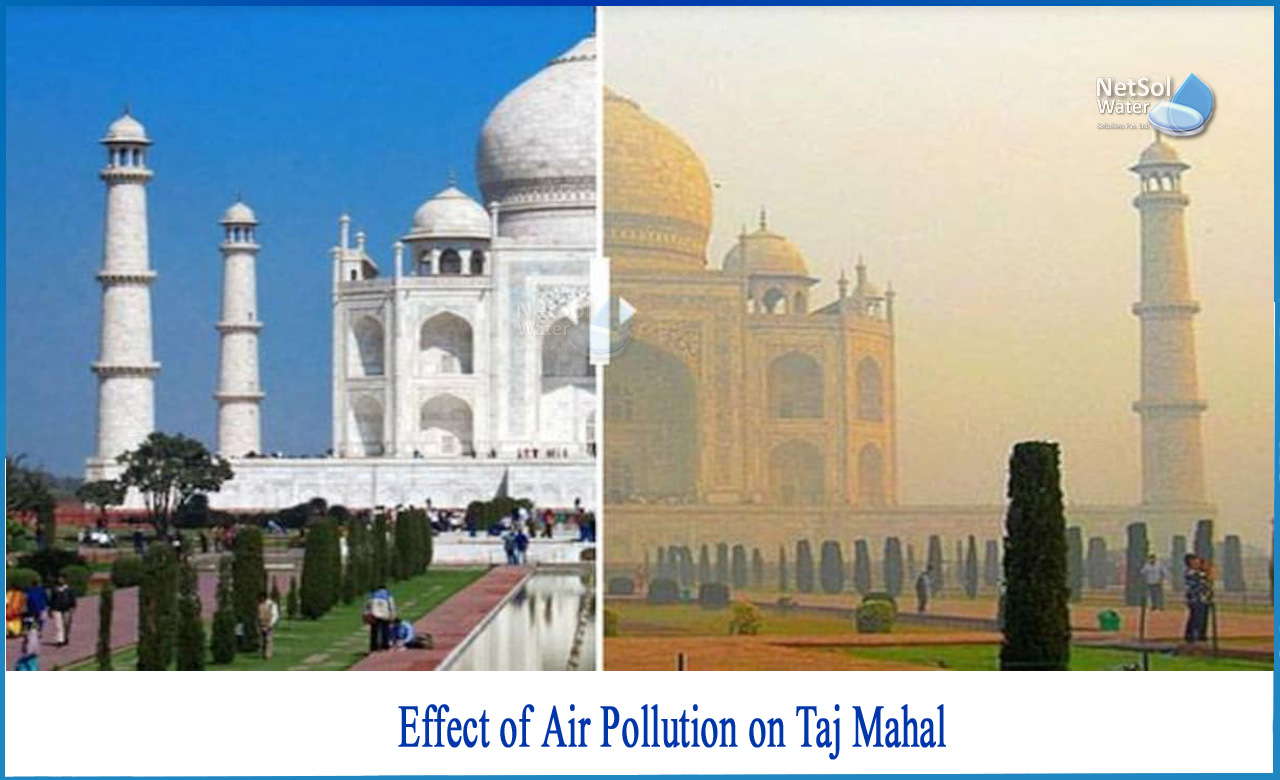What are the Effects of air pollution on Taj Mahal?
“Taj Mahal is pinkish in the morning, milky white in the evening, and golden when the moon shines, according to a legend.”
Though this may have been true in the past for the renowned flawless marble monument, pollution and bad management have now blanketed the Taj in a yellowy-brown film that lasts 24 hours. The Taj Mahal, one of the world's seven wonders, stands across a trash-strewn river and is frequently engulfed in dust and haze from billowing smokestacks and automobiles in the Northern city of Agra.
Insects from the drying Yamuna River, into which the city dumps its sewage, creep into the Taj Mahal, staining the marble with their excrement.
What caused the Taj Mahal's marble to turn into a different colour?
Taj Mahal's discolouration has been caused by a number of reasons.
To begin with, the Taj Trapezium Zone (TTZ) area is a major source of pollution due to polluting industry and automobile emissions. The second reason is that the Yamuna River, which flows behind the Taj, is extremely dirty. It is devoid of aquatic life and has resulted in insect and algae infestations on the Taj Mahal and other monuments along its banks.
In what ways do insects harm Taj Mahal?
The dry river Yamuna, which has lost its biological flow, is the source of this problem. According to the Archaeological Survey of India's research, these insects breed in the river's contaminated debris before attacking the Taj Mahal in the evening. There used to be fish in the river that ate the insects and their larvae, but now there are no signs of any aquatic species in the river due to severe water pollution.
A mausoleum in desperate need of rebirth
Natural oxidation processes – the marble equivalent of rust which have aged and darkened the Taj over the previous four centuries, but it has had no help from its inhospitable surroundings. It's been soaked in acid rain, caked in soot from industrial and home chimneys, and corroded by contaminants in the air.
Indian cities are notorious for their air pollution, and Agra is no exception. Increased car ownership, like in many Asian cities, has produced traffic congestion, while foul air seeps from Agra's oil refinery and tannery chimneys. Sulphur dioxide, NOx emissions, and primarily carbon-based particles have corroded and damaged the Taj's beautiful white façade, leaving it with a yellow sheen.Despite the installation of a 4,000-square-mile protection zone around the site (the Taj Trapezium Zone), inside which emissions are allegedly rigorously controlled, images show a significant deterioration in the Taj's condition in recent years.
Developers have long fought legal emission restrictions, which are frequently disregarded. Smoky funeral pyres are ignited, and garbage piles are often burned near to the structures. Pollution from the Yamuna River adds to the problem. The city's untreated sewage and industrial waste flows in, resulting in nutrient-rich streams. These nutrients are subsequently carried by the wind and deposited in the Taj's increasingly porous stonework, allowing river-derived microorganisms to thrive and turn the Taj green. Excrement from the many insects that thrive in the polluted river water is said to have hastened the damage, but this is a minor influence compared to the sulphur dioxide and nitrogen dioxide produced by fossil fuels.
What is the current state of affairs in comparison to when one first brought up the Taj's problems?
The position was far better in 1984, when the lawsuit for the Taj Mahal's protection was filed in the Supreme Court, than it is now. By providing many instructions, including proclaiming Agra a Heritage City, the Hon'ble Supreme Court provided a clear roadmap. The scenario may have been ideal if successive central and state administrations had taken all necessary steps to proclaim Agra a Heritage City.
Today, 35 years after we first petitioned the Supreme Court, it appears that we are again litigating the same concerns.
Because, Taj Mahal is a UNESCO World Heritage Site, obtaining input from both national and international experts and institutions will provide a more comprehensive viewpoint and vision for safeguarding the monument.
We, at Netsol Water believe in preserving our Environment and the beautiful heritage of our country from every type of pollution, be it, air, water, land, etc.
That is why we follow the goal of achieving sustainability for reviving our “Mother Nature”
Read More: What are the causes of this escalating Air pollution in Delhi?
Netsol Water is Greater Noida-based leading water & wastewater treatment plant manufacturer. We are industry's most demanding company based on client review and work quality. We are known as best commercial RO plant manufacturers, industrial RO plant manufacturer, sewage treatment plant manufacturer, Water Softener Plant Manufacturers and effluent treatment plant manufacturers. Apart from this 24x7 customer support is our USP. Call on +91-9650608473, or write us at enquiry@netsolwater.com for any support, inquiry or product-purchase related query.



